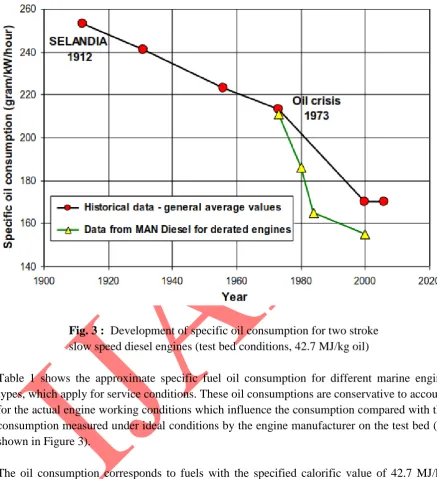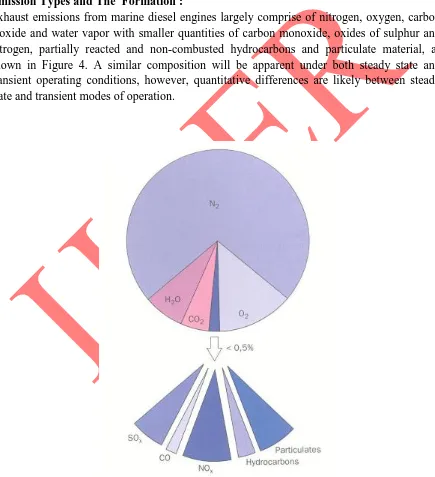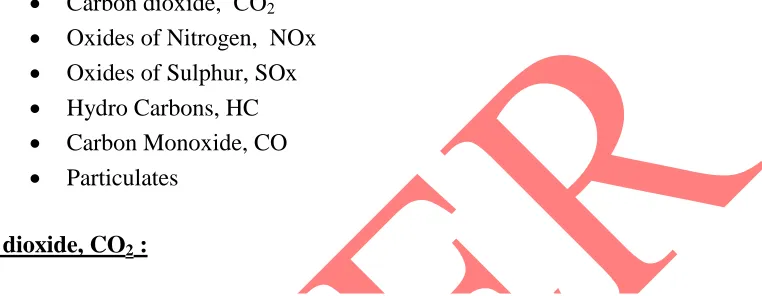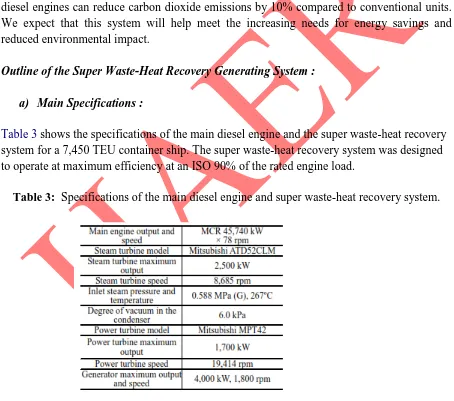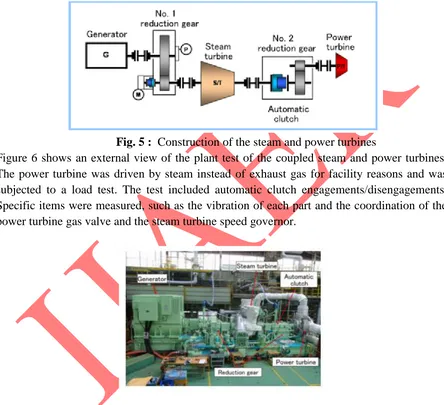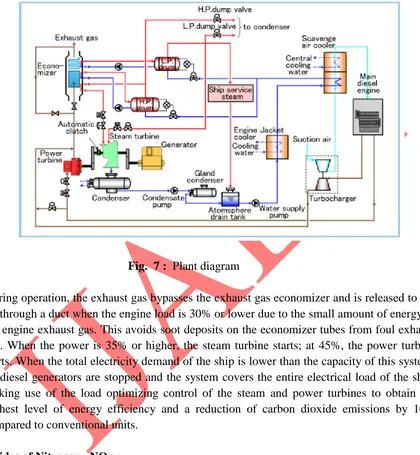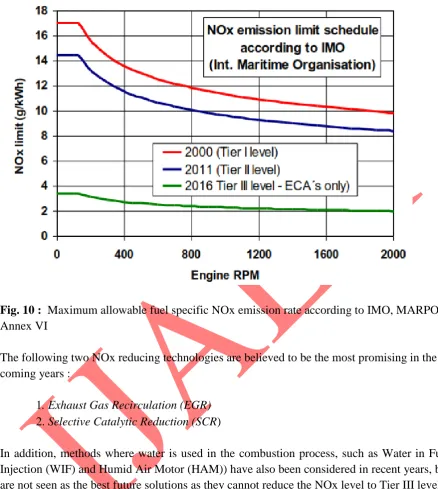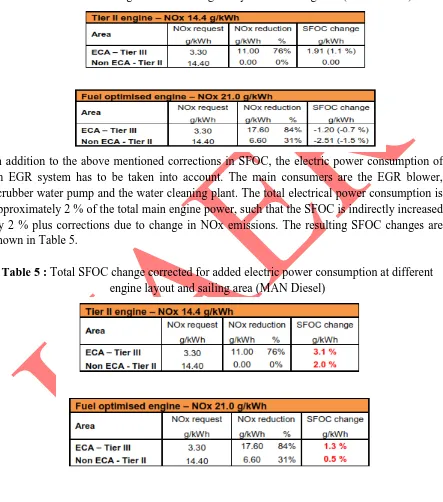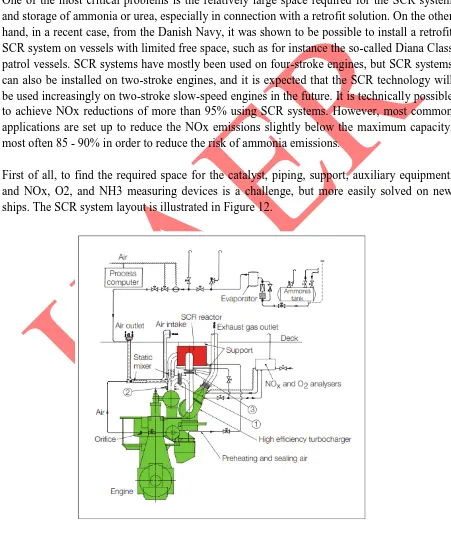1
INTERNATIONAL JOURNAL OF ADVANCES IN ENGINEERING RESEARCH
ENERGY DEMAND AND EXHAUST GAS
EMISSIONS OF MARINE ENGINES : MITIGATING
TECHNOLOGIES AND PREDICTION
V.THANIKACHALAM
Marine Engineering Department, HIMT College, Chennai.
ABSTRACT
In recent years more and more focus has been placed on the environmental aspects of ships, because of the great attention to exhaust gas emissions from ships including CO2, a leading contributor to Green House Gasses (GHG) emissions, due to their negative effect on global warming.
Maritime transport has clear environmental advantages: it expends relatively little energy and its infrastructure requirements are small compared to land-based transport modes. Due to low energy need, shipping is a highly carbon-efficient transport mode, i.e. carbon dioxide emissions are low compared to the weight of cargo transported. Shipping can be up to four times more efficient than road transport. Because of relatively small contribution to greenhouse gas emissions shipping is also good in the terms of mitigation of climate change.
However, air pollution from ships has been unregulated until recently. Ships currently produce about half as much sulphur oxides (SOx ) as land-based sources and about a third as much nitrogen oxides (NOx ). Ships emit several hazardous air pollutants such as sulphur dioxide, nitrogen oxides and fine particles. Once emitted, airborne emissions can travel considerable distances so the shipping emissions affect land air quality. Also the emissions from ships during port stays can be substantial contributor to the local air quality.
Thus,this report describes the different exhaust gas emission products, their untoward effects and the various ways in which it can be mitigated.
Key Words : Emissions, sulphur oxides (SOx ), nitrogen oxides (NOx), Green House Gases (GHG), Exhaust Gas Recirculation (EGR), Scavenge Air Moisturizing (SAM), Sulphur Emission Control Area (SECA).
INTRODUCTION
2
INTERNATIONAL JOURNAL OF ADVANCES IN ENGINEERING RESEARCH To prepare for coming regulations, general investigations and extensive research are carried out continuously. As shown in Figure 1, quite a number of emission control measures have already been developed, and are in use by the industry today. Emission control has turned into the most important driving force for development. Hence, this is an area to which extensive development effort is allocated.
Fig. 1 : Emission Reduction Methods.
This emphasises both NOx control, SOx limitation, particulate control and, to an increasing extent, CO2 emission. With CO2 considered a greenhouse gas, the CO2 concentration in the atmosphere is looked at with some anxiety. In any case, the low speed diesel is the heat engine available for ship propulsion with the lowest CO2 emission.
Many Diesel engine makers are in the process of introducing the advanced methods of internal methods for emission control. New tests have shown that it is possible to cut NOx emissions by more than 70% by means of exhaust gas recirculation (EGR). Humidification of the engine intake air (by means of SAM) is another method that has shown promising test results. SAM is currently being tested on a full-scale basis on board a car carrier.
As regards CO2, commercial shipstransport approx. 90% of all goods traded worldwide, and
3
INTERNATIONAL JOURNAL OF ADVANCES IN ENGINEERING RESEARCH Fig. 2 : CO2 Emissions per unit load by transport mode.
However, still, there are possibilities of increasing the efficiency by means of waste heat recovery and achieving a total efficiency of the fuel energy used of up to 60%. This will not only reduce the CO2 level, but also the amount of emissions of NOx, SOx, PM, CO and
HC.
In the 1990s, IMO, EPA and the EU concentrated their work on a reduction of NOx and SOx through MARPOL Annex VI. Tier II will continue the focus on lowering NOx for new buildings and SOx emissions for all ships in service. Also such exhaust gas components as particulates, unburned hydrocarbons and CO2 will be considered for future engine designs
and development.
ENERGY DEMAND AND EMISSION FACTORS
4
INTERNATIONAL JOURNAL OF ADVANCES IN ENGINEERING RESEARCH Engine types :
For ship propulsion the following engine types are used:
Slow speed two stroke diesel engines (50 – 300 RPM)
Medium speed four stroke diesel engines (300 – 1000 RPM)
High speed four stroke diesel engines (1000 – 3000 RPM)
Gas turbines (very high RPM > 5000)
Specific oil consumption :
The efficiency of diesel engines has constantly increased since the first maritime diesel engine was introduced on an ocean-going merchant ship, the SELANDIA in 1912. The improvement in marine diesel engine efficiency is shown in Figure 3, which shows the SFOC for two stroke engines based on data for MAN Diesel and Turbo engines since 1912 to 2012.
As can be seen, the oil crisis in 1973 had a pronounced influence on the specific oil consumption, which improved slow speed diesel engine fuel efficiency at a higher rate lowering specific fuel consumption to approximately 0.17 kg/kW/h until 2000, when the new NOx regulations MARPOL Annex VI legislation entered into force. These regulations stopped the steady decrease of the specific fuel oil consumption quite distinctly, as most of the NOx reducing measures have the general effect of counteracting possible fuel oil savings. The steadily improved engine efficiency is thus counteracted by the negative influence from the different NOx reducing initiatives, such that nearly constant specific fuel oil consumption has been observed since 2000.
5
INTERNATIONAL JOURNAL OF ADVANCES IN ENGINEERING RESEARCH Fig. 3 : Development of specific oil consumption for two stroke
slow speed diesel engines (test bed conditions, 42.7 MJ/kg oil)
Table 1 shows the approximate specific fuel oil consumption for different marine engine types, which apply for service conditions. These oil consumptions are conservative to account for the actual engine working conditions which influence the consumption compared with the consumption measured under ideal conditions by the engine manufacturer on the test bed (as shown in Figure 3).
6
INTERNATIONAL JOURNAL OF ADVANCES IN ENGINEERING RESEARCH Table 1: Approximate/typical SFOC values for different engine types (at 42.7 MJ/kg oil)
ENGINE TYPE SFOC VALUE (gram/kW/hour)
Slow speed engines 155 - 175
Medium speed engines 175 - 200
High speed engines 195 - 225
Gas turbines 240 - 300
Emission Types and The Formation :
Exhaust emissions from marine diesel engines largely comprise of nitrogen, oxygen, carbon dioxide and water vapor with smaller quantities of carbon monoxide, oxides of sulphur and nitrogen, partially reacted and non-combusted hydrocarbons and particulate material, as shown in Figure 4. A similar composition will be apparent under both steady state and transient operating conditions, however, quantitative differences are likely between steady state and transient modes of operation.
7
INTERNATIONAL JOURNAL OF ADVANCES IN ENGINEERING RESEARCH Oxides of Nitrogen :
The formation of oxides of nitrogen (NOx) occurs as a result of the oxidation of molecular nitrogen in the combustion air or the oxidation of organic nitrogen in the fuel. In the latter case it would be expected that the bulk of the organic nitrogen will be oxidized during the combustion process. Dependent upon the fuel, this organic nitrogen may account for a significant proportion of the total NOx emissions, particularly for engines operating on heavy fuel oil.
When considering oxidation of atmospheric nitrogen, the reaction will be influenced by local conditions in the combustion chamber with increased production of nitric oxide (NO), the primary reaction product, favored at high temperatures and at optimal air-to-fuel ratios within the engine. Later in the combustion cycle and during flow through the exhaust system, 5-10% of the NO formed will convert largely to nitrogen dioxide (NO2), while at the same time a limited proportion of nitrous oxide (N2O) will also be formed. Oxidation of NO to the more toxic NO2 will subsequently continue at ambient temperatures after expulsion from the exhaust system.
Adverse effects due to NOx are diverse. NO2 is of particular concern as it has detrimental effects on respiration and vegetation, as well as contributing significantly to acid deposition. In addition, NOx emissions, together with volatile organic compounds (VOC), are also involved in a series of photochemical reactions leading to an increase in tropospheric ozone, which in turn, may adversely affect human health, crop yield and natural vegetation. At a global level, N2O may also play a small part in both stratospheric ozone depletion and global climate change.
Carbon Dioxide and Water Vapour :
Carbon dioxide (CO2) and water vapor will be formed in all combustion processes in which complete, or nearly complete, combustion of a hydrocarbon fuel takes place with relative proportions being determined primarily by the hydrocarbon composition of the fuel. Thus the production of both CO2 and water vapor is a function of the quantity of fuel burnt, which to a large extent is determined by the engine power required, the plant efficiency and the elemental composition of the fuel being burnt.
Although, traditionally not regarded in the light of a pollutant, CO2 has become of increasing concern in recent years on account of its importance as a GHG and the consequences for global climate of the trend of rising CO2 concentration.
Oxides of Sulphur :
8
INTERNATIONAL JOURNAL OF ADVANCES IN ENGINEERING RESEARCH the combustion process to calcium sulphate. However, this is a relatively insignificant proportion and the sulphur emissions from the engine will essentially be proportional to the percentage sulphur mass content of the fuel. Concern over SO2 emissions lies in their detrimental effects to human respiration, vegetation and building materials.
Carbon Monoxide :
Carbon monoxide (CO) is a product of incomplete combustion of carbonaceous material. Its formation in the diesel engine is thus principally a function of the excess air ratio, the temperature of combustion and the uniformity of the air/fuel mixture in the combustion chamber. In general, CO emissions are low due to high excess oxygen concentrations and an efficient combustion process. However, in poorly maintained engines or at low power ranges, the proportion of CO may be expected to increase considerably in relative concentration. Concern over CO emissions is largely based on adverse health effects resulting from reduced oxygen carrying capacity of the blood in persons exposed to CO. Increasingly serious effects are apparent with prolonged exposure and range from impaired performance to respiratory failure and death. Broader environmental effects are not generally of major concern, although, carbon monoxide may have some small influence on global climate change.
Hydrocarbons :
The hydrocarbon (HC) fraction of the exhaust gas will predominantly consist of un-burnt or partially combusted fuel and lubricating oils. In reality, this fraction comprises a myriad of individual organic compounds with almost every chemically variation of C, H, O, N and S represented, albeit, at extremely low concentrations.
Individual components may be present in either vapor or particulate phases or may distribute between the two phases with evaporation, condensation and polymerization reactions leading to a constantly changing distribution. Consequently, the diverse nature of the hydrocarbon fraction components makes for difficulties in both quantifying the emissions and in identifying the specific health and environmental problems. In general, health effects range from drowsiness and eye irritation at one end of the spectrum to high toxicity, mutagenicity and carcinogenicity at the other. These latter effects are discussed under 'micro pollutants'.
In general, hydrocarbon emissions will result from incomplete combustion. The nature and levels of hydrocarbons in the exhaust will, thus, be largely dependent upon the combustion characteristics and thermal efficiency of the engine, which in turn are significantly influenced by engine load and condition.
Particulates :
9
INTERNATIONAL JOURNAL OF ADVANCES IN ENGINEERING RESEARCH may also be encountered. With the exception of the latter, the majority of diesel particulates are likely to be less than μm in diameter, readily transportable by air currents and of low settling velocity. Potentially detrimental effects may thus be encountered away from the immediate vicinity of the exhaust gas plume.
Although, studies of the marine diesel particulate exhaust composition are limited, extrapolation of results from other diesel engine applications would suggest that general respiratory problems, as well as more serious toxic, mutagenic and carcinogenic effects, may potentially occur. To a large extent, the magnitude of particulate emissions is dependent upon the completeness of combustion, with 'smoke' traditionally acting as a measure of combustion quality. However, quantification of this fraction is difficult due to the complex nature of the particulate emissions and multiple terms employed to describe both the nature and quantity of particulate matter. Many terms are derived from, and defined by, sampling and quantification methods and include the suspended particulate matter and the total suspended particulates.
Terms, such as 'inhalable' or 'respirable' relate to the site of deposition in the respiratory tract, whilst PM1O (particulate matter with an aerodynamic diameter of less than 10 μm) has both a physiological and sampling component
Micro pollutants :
The term micro pollutants generally refers to those pollutants present in trace quantities, typically of the parts per billion level, which demonstrate severe adverse effects even at these low concentrations. In the context of diesel engine exhaust emissions, micro pollutants will encompass both organic micro pollutants and heavy metals.
Organic micro pollutants typically include such trace organic contaminants as polyaromatic hydrocarbons (PAH), dioxins and furans. With respect to the combustion processes, the presence, and in many cases carcinogenicity, of PAH in the exhaust gas stream are well documented. More recently highly mutagenic nitrated PAH have also been identified and are believed to originate from chemical reaction between PAH and NOx in the exhaust system. In addition, highly toxic emissions of polychlorinated biphenyls (PCB), polychlorinated dibenzodioxins (PCDD) and polychlorinated dibenzofurans (PCDF) have also been reported. These latter compounds being amongst the most toxic substances presently identified. However, any significant concentrations of polychlorinated compounds are only likely to be associated with isolated incidences of chemical contamination of oil fuels.
10
INTERNATIONAL JOURNAL OF ADVANCES IN ENGINEERING RESEARCH Heavy metals are well known inhibitors of biological processes with toxic effects mediated through the poisoning of enzymes involved in biochemical reactions. As such, effects are widespread ranging from reduced diversity of aquatic ecosystems, through fish kills to cancer in man.
Mitigating Technologies for the following products emitted as a result of the combustion process:
Carbon dioxide, CO2
Oxides of Nitrogen, NOx
Oxides of Sulphur, SOx
Hydro Carbons, HC
Carbon Monoxide, CO
Particulates
Carbon dioxide, CO2 :
Although international shipping is the most energy efficient mode of mass transport and only a modest contributor to overall carbon dioxide (CO2) emissions, a global approach to further improve its energy efficiency and effective emission control is needed as sea transport will continue growing apace with world trade.
As already acknowledged by the Kyoto Protocol, CO2 emissions from international shipping cannot be attributed to any particular national economy due to its global activities and complex operation. Therefore, IMO has been energetically pursuing the limitation and reduction of greenhouse gas (GHG) emissions from international shipping, in recognition of the magnitude of the climate change challenge and the intense focus on this topic.
According to the Second IMO GHG Study 2009, which is the most comprehensive and authoritative assessment of the level of GHG emitted by ships, international shipping was estimated to have emitted 870 million tonnes, or about 2.7% of the global man-made emissions of CO2 in 2007. In addition, the study shows that the emission of CO2 is proportional with the fuel oil consumption by following fuel specific emission rates as shown in Table 2. Exhaust gases are the primary source of GHG emissions from ships and carbon dioxide is the most important GHG, both in terms of quantity and of global warming potential.
Table 2 : Emission of CO2 in relation to the various fuel oil consumption.
TYPE OF FUEL OIL CO2 EMISSION RATE
11
INTERNATIONAL JOURNAL OF ADVANCES IN ENGINEERING RESEARCH Diesel Oil/Gas Oil (DO/GO) 3.206 t/t oil
Liquefied Natural Gas (LNG) 2.750 t/t gas
Liquefied Petroleum Gas (LPG) 3.000 t/t Propane and 3.003 t/t Butane LNG/DO 2.78 t/t fuel
The Study identifies a significant potential for reduction of GHG emissions through technical and operational measures. The Study estimates that, if implemented, these measures could increase efficiency and reduce the emissions rate by 25% to 75% below the current level.
Recently, operators worldwide have been obliged to reduce carbon dioxide emissions due to COP 15 and other regulations. Thereby the Super waste-heat recovery system for marine diesel engines can reduce carbon dioxide emissions by 10% compared to conventional units. We expect that this system will help meet the increasing needs for energy savings and reduced environmental impact.
Outline of the Super Waste-Heat Recovery Generating System :
a) Main Specifications :
Table 3 shows the specifications of the main diesel engine and the super waste-heat recovery system for a 7,450 TEU container ship. The super waste-heat recovery system was designed to operate at maximum efficiency at an ISO 90% of the rated engine load.
Table 3: Specifications of the main diesel engine and super waste-heat recovery system.
b) Combined Power Train of the Steam and Power Turbines :
12
INTERNATIONAL JOURNAL OF ADVANCES IN ENGINEERING RESEARCH through the automatic clutch. The power turbine rotation is reduced by one-stage reduction gears from 20,000 rpm to 8,700 rpm to couple it with the steam turbine. The power turbine and the pinion gear in the reduction gear are connected with a flexible coupling, and the wheel gear in the reduction gear and the steam turbine shaft are coupled with the automatic clutch and flexible coupling. The steam turbine is a condensing axial-flow impulse turbine based on a conventional model. The power turbine is an adapted MET turbocharger.
Fig. 5 : Construction of the steam and power turbines
Figure 6 shows an external view of the plant test of the coupled steam and power turbines. The power turbine was driven by steam instead of exhaust gas for facility reasons and was subjected to a load test. The test included automatic clutch engagements/disengagements. Specific items were measured, such as the vibration of each part and the coordination of the power turbine gas valve and the steam turbine speed governor.
Fig. 6: Test operation with combined turbines
c) Plant Diagram of the Super Waste-Heat Recovery System :
13
INTERNATIONAL JOURNAL OF ADVANCES IN ENGINEERING RESEARCH drive the power turbine. A bypass valve installed on the exhaust extract line is used to prevent the scavenging pressure from rising suddenly due to the power turbine trip or other factors.
Fig. 7 : Plant diagram
During operation, the exhaust gas bypasses the exhaust gas economizer and is released to the air through a duct when the engine load is 30% or lower due to the small amount of energy in the engine exhaust gas. This avoids soot deposits on the economizer tubes from foul exhaust gas. When the power is 35% or higher, the steam turbine starts; at 45%, the power turbine starts. When the total electricity demand of the ship is lower than the capacity of this system, all diesel generators are stopped and the system covers the entire electrical load of the ship, making use of the load optimizing control of the steam and power turbines to obtain the highest level of energy efficiency and a reduction of carbon dioxide emissions by 10% compared to conventional units.
Oxides of Nitrogen, NOx :
14
INTERNATIONAL JOURNAL OF ADVANCES IN ENGINEERING RESEARCH where practically all NOx has to be removed. SCR is less suited for low-load operation and manoeuvring in coastal and harbour areas.
Tier II, which entered into force on 1 January 2011, lowered the Tier I level by 2.6 g/kWh NOx in the relevant speed region for new built two-stroke engines. And, Tier III, which is to enter into force on 1 January 2016, reduces the existing Tier I level by 80% across the entire speed limit NOx curve for new engines, but only in defined local areas near shore. Outside this area, the Tier II level will be in force, as shown in Figure 8.
Fig. 8 : IMO NOx limits.
Furthermore, a regulation for existing pre-year 2000 engines will be introduced, since the contribution of emissions from these engines will exist for still many years to come. All relevant engines can be updated by internal methods to meet Tier II.
This can be achieved by introducing new fuel system components like plunger/barrel and fuel valve nozzles, and by an adjustment of the combustion chamber volume by piston rod shims, the scavenge air pressure, the exhaust cam profile and electronic control.
15
INTERNATIONAL JOURNAL OF ADVANCES IN ENGINEERING RESEARCH The study showed a promising trade-off between the engine fuel consumption and the NOx level. Such studies are now a part of very promising development work. Results are shown in Figure 9.
Fig. 9 : Relative change in SFOC and NOx at 75% load
The fuel specific NOx emission rate for diesel engines depends on different factors of which one is the engine type and an another factor is the fuel type. Slow speed engines have generally higher NOx emissions compared with medium speed engines, which is also reflected in the demands already imposed by IMO in the MARPOL Annex VI: “Regulations for the Prevention of Air Pollution from Ships”. New NOx demands came into force in May 2005, however, with the clause that all diesel engines manufactured after January 2000 has to fulfill the NOx demands, as shown in Figure 10.
In 2016 Tier III level will only be introduced in ECA areas, but the extent of these areas will most probably be larger in the coming years. Gas turbines have a clear advantage with a NOx emission factor of only 4 g/kW/hour - for some gas turbines NOx emissions can be even lower !
16
INTERNATIONAL JOURNAL OF ADVANCES IN ENGINEERING RESEARCH Fig. 10 : Maximum allowable fuel specific NOx emission rate according to IMO, MARPOL Annex VI
The following two NOx reducing technologies are believed to be the most promising in the coming years :
1. Exhaust Gas Recirculation (EGR) 2. Selective Catalytic Reduction (SCR)
In addition, methods where water is used in the combustion process, such as Water in Fuel Injection (WIF) and Humid Air Motor (HAM)) have also been considered in recent years, but are not seen as the best future solutions as they cannot reduce the NOx level to Tier III level.
EGR - Exhaust Gas Recirculation :
Exhaust Gas Recirculation is a method to significantly reduce NOx emissions from marine engines. It is proven to be able to meet the Tier III NOx requirements, which will apply to all new ships entering a NOx Emission Control Area (ECA) from 2016.
17
INTERNATIONAL JOURNAL OF ADVANCES IN ENGINEERING RESEARCH catcher and finally through the EGR blower which lifts the pressure to the scavenge air pressure. A water handling system supplies the scrubber with re-circulating fresh water with the addition of NaOH to neutralize the effect of sulphur in the fuel.
The effect of this system will be that a minor part of the oxygen in the scavenge air is replaced by CO2 from the combustion. The heat capacity of the scavenge air will be slightly increased and the temperature peaks of the combustion will be reduced. Accordingly the amount of NOx generated in the combustion chamber is reduced but it is also followed by a minor fuel penalty. The NOx reduction value is dependent of the ratio of re-circulating gas.
Fig. 11 : Principles of an EGR system (MAN Diesel)
SFOC change due to use of EGR :
The final SFOC change of a Tier II engine and a fuel optimized engine is shown in Table 4. In ECA areas, as well as non ECA areas, the fuel optimized engine shows a better performance than a Tier II engine. However, other EGR costs needs to be taken into consideration when evaluating the engine layouts.
18
INTERNATIONAL JOURNAL OF ADVANCES IN ENGINEERING RESEARCH consumption is estimated to be approximately 1% lower compared with a Tier II engine without EGR.
Table 4 : SFOC change at different engine layout and sailing area (MAN Diesel)
In addition to the above mentioned corrections in SFOC, the electric power consumption of an EGR system has to be taken into account. The main consumers are the EGR blower, scrubber water pump and the water cleaning plant. The total electrical power consumption is approximately 2 % of the total main engine power, such that the SFOC is indirectly increased by 2 % plus corrections due to change in NOx emissions. The resulting SFOC changes are shown in Table 5.
Table 5 : Total SFOC change corrected for added electric power consumption at different engine layout and sailing area (MAN Diesel)
SCR - Selective Catalytic Reduction :
19
INTERNATIONAL JOURNAL OF ADVANCES IN ENGINEERING RESEARCH emissions of up to 90 - 95%. To reach a 90% NOx reduction, approximately 15 g of urea is needed per kWh energy from the engine. In addition to the catalyst that ensures reduction of NOx, the cleaning technology may also include an oxidation step, resulting in significant reduction of HC, CO and particles. In addition to the SCR catalyst, an SCR system consists of a reactor tank, a pump and control system for dosage of ammonia/urea.
One of the most critical problems is the relatively large space required for the SCR system and storage of ammonia or urea, especially in connection with a retrofit solution. On the other hand, in a recent case, from the Danish Navy, it was shown to be possible to install a retrofit SCR system on vessels with limited free space, such as for instance the so-called Diana Class patrol vessels. SCR systems have mostly been used on four-stroke engines, but SCR systems can also be installed on two-stroke engines, and it is expected that the SCR technology will be used increasingly on two-stroke slow-speed engines in the future. It is technically possible to achieve NOx reductions of more than 95% using SCR systems. However, most common applications are set up to reduce the NOx emissions slightly below the maximum capacity, most often 85 - 90% in order to reduce the risk of ammonia emissions.
First of all, to find the required space for the catalyst, piping, support, auxiliary equipment, and NOx, O2, and NH3 measuring devices is a challenge, but more easily solved on new ships. The SCR system layout is illustrated in Figure 12.
20
INTERNATIONAL JOURNAL OF ADVANCES IN ENGINEERING RESEARCH Working principle with the SCR technique, the exhaust gas is mixed with ammonia NH3 or urea (as NH3 carrier) before passing through a layer of a special catalyst at a temperature between 300°C and 400°C, whereby NOx is reduced to N2 and H2O.
The reactions are, in principle, the following (see Figure 13):
4NO + 4NH3 + O2 → 4N2 + 6H2O
6NO2 + 8NH3 → 7N2 + 12H2O
The design of the SCR catalyst is based on the sulphur content, temperature limits, expected dust content from the composition of the exhaust gas and the permissible pressure drops across the SCR reactor.
To keep the temperature within the limits, the SCR catalyst must be located between the exhaust gas receiver and the turbocharger, so that the SCR catalyst can sustain the pressure at the turbocharger inlet. With a high pressure at the inlet, the SCR can be reduced in size compared to catalysts on some medium and high speed engines, where the SCR unit is located in the exhaust gas funnel.
21
INTERNATIONAL JOURNAL OF ADVANCES IN ENGINEERING RESEARCH Fig.13 : Selective Catalytic Reduction (SCR) process
The SCR process is feasible on twostroke diesel engines with only minor impact on the engine performance, but with restrictions on the engine load, sulphur content, cylinder lube oil, and excess of ammonia (or urea).
Experience on ships indicates that a CEMS (Continuous Emission Monitoring System) can pose a challenge for operators. Various CEMS equipment is on the market and many are in the process of further development. CEMS is expected to become mandatory equipment in connection with Tier III.
Oxides of Sulphur, SOx :
In SECA ( SOx Emission Control Area ) the following applies according to IMO Annex VI of Marpol 73/78, where at least one of the following conditions shall be fulfilled:
• The sulfur content of the fuel used shall not exceed 1.5% w/w.
• An exhaust gas cleaning system is applied to reduce the total emission of sulfur oxides (including both auxiliary and main propulsion engines) to 6.0 g SOx /(kW h) or less (calculated as SO2).
Sulphur di oxide (SO2 ) is proportional with the fuel oil consumption and the content of sulphur in the oil by the following theoretical fuel specific emission rate equation:
22
INTERNATIONAL JOURNAL OF ADVANCES IN ENGINEERING RESEARCH Where S is the percentage mass sulphur content in the fuel, as shown in Figure 14 (Lloyds Register 1995).
It is seen that the lower the sulphur content is the lower fuel specific emission rate of SO2, which is the reason why more and more strict demands towards lower sulphur content are imposed on oil for marine diesel engines in the coming years. Concern over pollution is likely to mean that heavy fuel oils with a sulphur content below the current average of more than 2% will become more common in the years ahead, as forthcoming legislation restricts emission limits of both SOx and NOx.
23
INTERNATIONAL JOURNAL OF ADVANCES IN ENGINEERING RESEARCH
In October 2008, the 58th IMO MEPC session adopted significant changes to Annex VI under Resolution MEPC.176(58). This introduced a reduction in the global sulphur fuel limit to 3.5 percent from 1 January 2012 with a further global reduction to 0.5 percent from 1 January 2020.
The revised Annex VI also introduced a tiered reduction to the sulphur content of fuels for use in Emission Control Areas (ECA) to 1.0 percent from I July 2010 and more significantly,0.1 percent from 1 January 2015 (see Table 6).
Table 6 : Fuel Oil Sulphur Limits.
Reduction of SOx emissions :
SO2 emissions can be reduced either by using fuels with low sulphur content, which makes the fuel more expensive. An alternative solution is to use so-called scrubbers, which can be used for washing the exhaust gas from the main engine, and in principle it can be compared to a large shower cabinet placed in the funnel of a ship. It is possible to reduce the sulphur emissions by 98 %, i.e. to a level as low as if low sulphur fuel oil was used. Scrubbers can use both fresh water mixed with caustic soda (NaOH) and salt water in the washing process. Scrubbers can reduce SOX and particulate matter with little increase in fuel consumption for electrical power generation, mainly to feed pumps to circulate water (approximately 3 % according to Alfa Laval).
Wet scrubbers :
24
INTERNATIONAL JOURNAL OF ADVANCES IN ENGINEERING RESEARCH
scrubbers are normally open loop type, where the water is sourced and discharged from outside the system and the water flows only once through the unit. In a closed loop type of scrubber, the treatment water is cleaned and recycled back to the scrubber in a continuous closed loop. In a closed loop system particulate matter and other residues have to be removed from the water and the water treated to maintain its pH and then make it suitable for reuse in the scrubber.
There are advantages to open loop type systems, such as the avoidance of purchasing and handling caustic soda, and the avoidance of the need to process wash water. The closed loop system has the advantages that the scrubberworks with the same efficiency independentlyof where the vessel is operating and there islittle or no water discharge, making it best suited for coastal, port and inland waters.
In order to utilize the advantages of both systems, some manufacturers have proposed
25
INTERNATIONAL JOURNAL OF ADVANCES IN ENGINEERING RESEARCH Fig. 15 : Hybrid Scrubber Systems.
However, wash water throughput volume is another parameter that impacts scrubber effectiveness. Even when using wash water with a lower alkaline pH, a SOx removal rate to the required levels can possibly be achieved if sufficient volume of wash water is used.
26
INTERNATIONAL JOURNAL OF ADVANCES IN ENGINEERING RESEARCH Table 7 : Wet Scrubber Effectiveness Rates.
The operating pattern of a ship will influence the process of determining which type of scrubber system is to be considered for a particular application.
Hydro Carbons ( HC ) and Carbon Monoxide ( CO ) :
HC and CO emission factors are partly based on the measurements done by Lloyds Register (Lloyds Register 1995) and the results from MAN Diesel (Pedersen et al. 2010) with tests with different fuel valves (conventional and sliding valves) have shown that slide fuel valves reduce emissions of HC, valves (conventional and sliding valves) have shown that slide fuel valves reduce emissions of HC, CO and particulate maters. Slide fuel valves are introduced to meet the stricter Tier II NOx requirements.
There can be quite large variations in the emission factors depending on the engine loading (steady state/transient). For marine diesel engines the variation in steady-state mode is as follows, according to Lloyds Register 1995:
NOx: 8 - 20 g/kW/hour HC: 0.2 – 1.0 g/kW/hour CO: 0.4 – 4.0 g/kW/hour
27
INTERNATIONAL JOURNAL OF ADVANCES IN ENGINEERING RESEARCH Unlike spark-ignited engines where the combustible mixture is predominantly homogeneous, diesel combustion is heterogeneous in nature. Diesel fuel is injected into a cylinder filled with high temperature compressed air. Emissions formed as a result of burning this heterogeneous air/fuel mixture depend on the prevailing conditions not only during combustion, but also during the expansion and especially prior to the exhaust valve opening. Mixture preparation during the ignition delay, fuel ignition quality, residence time at different combustion temperatures, expansion duration, and general engine design features play a very important role in emission formation. In essence, the concentration of the different emission species in the exhaust is the result of their formation, and their reduction in the exhaust system. Incomplete combustion products formed in the early stages of combustion may be oxidized later during the expansion stroke. Mixing of unburned hydrocarbons with oxidizing gases, high combustion chamber temperature, and adequate residence time for the oxidation process permit more complete combustion.
Figure 16 summarizes the sources of unburned hydrocarbons (HC) and NO in direct-injected diesel engines. Species formed in both the premixed and diffusion (mixing controlled) combustion phases are shown.
Fig. 16 : Pollutant Formation Mechanisms in DI Combustion System
28
INTERNATIONAL JOURNAL OF ADVANCES IN ENGINEERING RESEARCH Table 8 : Specific HC and CO emission for diesel engines.
HC ( g/kWh ) CO ( g/kWh )
2 Stroke diesel engine 0.5 0.35
4 Stroke diesel engine 0.5 0.5
Fig. 17 : HC emissions for 2 stroke engines Fig. 18 : CO emissions for 2 stroke engines
(C* and F* fulfil Tier II NOx levels, CIMAC 2010) (C*and F* fulfil Tier II NOx levels, CIMAC 2010)
Particulates, PM :
Gaseous and particulate emissions from marine vessels gain increasing attention due to their significant contribution to the anthropogenic burden of the atmosphere, the change of the atmospheric composition and the impact on local and regional air quality and climate.
The emission of particulates have been found to be particularly affected by the sulphur content as shown in Figure 19 with results from different investigations. Based on these curves the following equation has been derived for the particulate emission factor for diesel engines:
29
INTERNATIONAL JOURNAL OF ADVANCES IN ENGINEERING RESEARCH Fig.19 : Relationship between fuel sulphur content and emissions of particulates, PM (Lloyds
Register 1995 and CIMAC 2010)
The particle number EF ( Emission Factors ) decreases for particles larger than 100 nm and is typically 3 orders of magnitude lower in relation to the combustion aerosol mode. The
intensity of this “exhaust particle contribution” also increases with decreasing speed of the vessels implying a more incomplete combustion process and a simultaneous increase of black carbon.
CONCLUSION
In recent years, several developments have turned the environmental „spotlight‟ on shipping. Much more research has been done on the subject to improve our understanding of the nature and scale of the problem.
Tier II and Tier III of IMO Annex VI are currently being settled in order to specify the acceptable levels of exhaust gas emissions in the years to come. Many engines will be able to meet the Tier II NOx limits by internal engine methods. The expected Tier III 80% NOx reduction requirement can only be met by the use of external engine methods such as SCR.
According to IMO, SOx and PM will be reduced by fuel sulphur level limits. Alternatively, an abatement system can be installed, e.g. a fuel oil scrubber solution. Manufacturers are also investigating this option to ensure a safe, reliable and environmentally friendly operation of diesel propelled vessels.
30
INTERNATIONAL JOURNAL OF ADVANCES IN ENGINEERING RESEARCH advancing as an important fuel of the future. However, establishing LNG bunkering facilities, comprising small-sized LNG terminals and a network of LNG supply ships, is costly and time-consuming and, furthermore, subject to safety concerns and broad public debate. Currently, only a few countries (e.g. Norway) have a LNG network in place to support the general use of gas as a marine fuel.
Gas gives a much cleaner exhaust regarding NOx and particulates, having very low or no sulphur (< 0.01%), and therefore, sulphur oxide emissions are negligible in the exhaust gas and particulates are reduced considerably. For certain two-stroke engines, the NOx reduction is 10-20% because they are working as dual fuel engines using small amount of pilot diesel fuel injected to ignite the natural gas fuel.
The International Council on Clean Transportation (2007: 10) acknowledge that „a low fleet turnover rate means that the largely uncontrolled vessels that make up the majority of the international shipping fleet today will continue to pollute for several decades before they are retired‟. The potential exists to retrofit ships with devices that improve fuel efficiency and cut emissions, but Marintek et al (2000) expect the diffusion of environmental technology in the shipping industry to be primarily through new build rather than retrofitting. In response to the surge in demand for global shipping services since 2000, a large amount of new capacity that meet higher standards of fuel efficiency and emissions has entered service in recent years.
To meet the environmental targets that have been set by governments and international organizations, efforts to design and commercialize greener vehicles are likely to intensify. Designers‟ environmental priorities are also likely to change. The overriding emphasis on minimizing noxious gases is likely to give way to a more holistic view of the „green vehicle‟ that achieves a better balance of clean air, climate change and safety objectives.
REFERENCES
[1] ABS ( 2012 ), “ Exhaust Gas Scrubber System”.
[2] Alan Mckinnon et al., “ Green Logistics
[3] Andreasen A., “ Use of Seawater Scrubbing for SO2 Removal from Marine Engine Exhaust Gas”.
[4] Andy Wright, “Exhaust Emissions from Combustion Machinery “.
[5] Arnold W. Reitze, “ Air Pollution Control Law : Compliance and Enforcement “.
[6] Bengtsson S. et al., “A comparative life cycle assessment of marine fuels: liquefied natural gas and three other fuels”.
31
INTERNATIONAL JOURNAL OF ADVANCES IN ENGINEERING RESEARCH [8] Diesch J. M., “Investigation of gaseous and particulate emissions from various marine vessel types measured on the banks of the Elbe in Northern Germany”.
[9] Frederic Beaudry, “ Greenhouse Gases for Beginners”.
[10] Harilal S. Sorathia, “ Effect of EGR on NOx Emission from C.I. Engine – A Review Study “.
[11] Hussain J., “ Effect of EGR on performance and Emission Characteristics”.
[12] International Maritime Organization ( IMO ) ( 2009), “ Greenhouse Gas Study”.
[13] Kristensen H. O., “ Energy Demand and Exhaust Gas Emissions of Marine Engines “.
[14] Lloyds Register of Shipping ( 1995 ), “ Marine Exhaust Emissions Research Programme “.
[15] Maeda K. et al., “ PM Emission from Ships – How to measure and reduce PM during voyage “ - CIMAC paper No. 87, 2010
[16] Magdi K. Khair, “ Emission Formation in Diesel Engines “.
[17] MAN B&W Diesel A/S, Copenhagen, ( Aug. 2009 ), “Exhaust Gas Emission Control Today and Tomorrow “.
[18] Marintek et al ( 2000 ), “ Study of Greenhouse Gas Emissions from Ships “ – Final Report to IMO, Trondheim.
[19] Michael Paloez, “ Decreasing Fuel Consumption and Exhaust Gas Emissions in Transportation “.
[20] Mitsubishi Heavy Industries Technical Review ( March 2011 ), “ Development of Super Waste – heat Recovery System for Marine Diesel Engines “.
[21] Murphy A.J., “ Exhaust Gas Emissions Mitigating Technologies and Prediction “.
[22] Pedersen M. F., Andreasen A. and Mayer S., “Two stroke engine emission reduction technology: State-of-the-art “ - CIMAC paper No. 85, 2010.
[23] Ristimaki J., Hellen G. and Lappi M., “ Chemical and physical characterization of exhaust particulate matter from a diesel engine “. - CIMAC paper No. 72, 2010
[24] Wright A. A., “ Exhaust Emissions from Combustion Machinery (Marine Engineering
